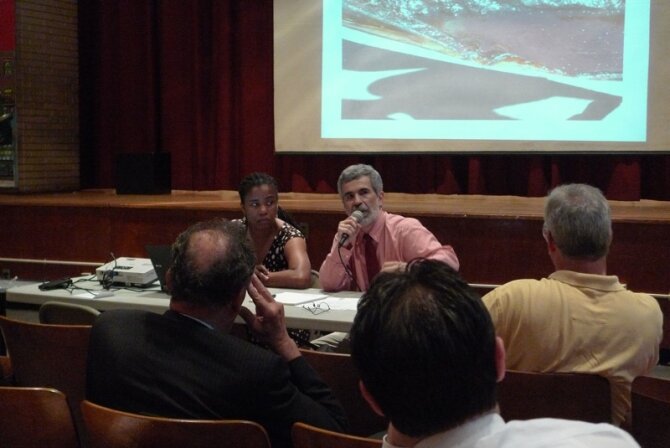EPA Gives Community The Bottom Line
At this month’s EPA Gowanus CAG meeting, our project manager and friend Christos Tsiamas delivered a sobering assessment of the conditions at the canal and the methods of remediation that will likely be utilized.
Christos has reviewed not only the EPA studies, but the work of the Army Corp of Engineers, the NYC DEP and the independent agencies hired by responsible parties such as National Grid. Christos has also consulted with each of these parties and plans on continuing to do so as the EPA continues to develop it’s remediation plan.
As noted in the EPA’s RIT report core samples revealed pollution down to levels as deep as 80 feet. This may not be the extent of the pollution it was simply the limit of the core samples taken. This density of pollution is present adjacent to both the former petroleum distillation plants and in some other areas as well, notably under the Lowes parking lot.
Christos presented the three main techniques the EPA has available to clean-up a site such as ours, those being chemical treatment, removal and capping. Summarizing his presentation, here is the applicability of each method:
1. Chemical treatments - using bacteria and enzymes to convert the pollutants into an inert form is not deemed viable for the canal due to both the variety of pollutants and to the presence of heavy metals which cannot be treated in this manner.
2. Removal - there is a layer of soft material which runs approximately 12 feet deep and which will most likely be dredged and removed. Unfortunately it is not possible to dredge 50 or 60 feet down into the canal bed to remove the source of this material - a gelatinous, petrochemical ooze. Due to the soft nature of the earth under the canal, dredging that deeply would cause the canal uplands to collapse into the canal. This leaves only one solution:
3. Capping - this involves determining a level at which to dredge to and them applying a cover of clay, sand and/or rock to seal in the toxic flows. This technique has been used at upland sites adjacent to the canal such as the Lowes parking lot and is being used in other areas such as the Public Place site.
Christos went on to discuss two other sources of concern regarding the canal, first re-pollution of canal water from sources such as water run-off from the streets and the second re-pollution from organic matter overflowing into the canal from the CSOs. While no specific solution has been determined for either, Christos is continuing to meet with the Conservancy and DLand Studio to discuss run off containment and with the City and NYCDEP in particular to develop solutions for the CSOs (containment tanks, et al).
Several people asked about the potential to use bio-remediation in the canal clean-up; this is a subject I will explore in greater depth in another article. Christos' response was to note that all the EPAs work is green and is meant to promote and to produce a more natural and cleaner environment.
It’s unfortunate to learn that in 150 years a condition has been created where we cannot actually clean our canal, where the best we can hope to achieve is to protect ourselves from the toxic condition below. Unfortunately, this is the conclusion that the EPA is leaning toward. One has to wonder how well we can protect ourselves from the soil beneath us and whether this area will ever really be suitable for residential development as is being so quickly developed at Public Place.

